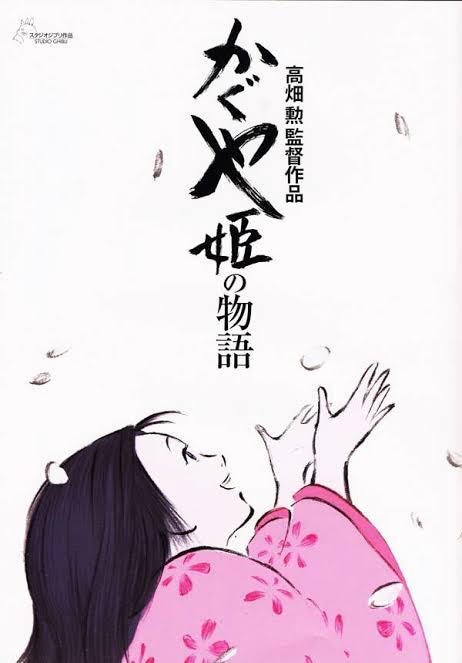
Title: The Tale of Princess Kaguya [かぐや姫の物語 (Kaguya-hime no monogatari)
Director: Isao Takahata
Released: 2013
Country: Japan
Language: Japanese
English Subtitles: Yes
Closed Captioning: Yes
Streaming/Available on: HBO Max; Amazon Prime Video (Japanese audio with English subtitles and English audio versions both available)
Up next for the World Englishes Committee’s World Cinema Spotlight is The Tale of Princess Kaguya, かぐやの物語 (kaguya no monogatari), a Studio Ghibli film directed by Isao Takahata. While Studio Ghibli is perhaps best known for Hayao Miyazaki’s international hits such as Princess Mononoke, My Neighbor Totoro, and Spirited Away, Takahata’s Kaguya holds its own, from the plotline to the artistry and the soundtrack. The story is based on an ancient Japanese legend known as “The Tale of the Bamboo Cutter,” 竹取物語 (taketori monogatari). The legend dates as far back to the Heian period of Japan in the 10th century, and in fact is one of the oldest written monogatari, or fictional tales. In the legend, an old bamboo cutter discovers a Thumbelina-esque princess inside a bamboo shoot; he and his wife then decide to raise her as their own daughter. While the basic plot is the same between the original monogatari and the film adaptation, the film adds additional social context for its titular character, Kaguya, by giving her a group of similarly-aged friends at the beginning of the movie. While a story based on a folk tale might sound simplistic, Kaguya pulls a great deal of emotional weight, grappling with sophisticated themes such as the transience of nature and life; the conflict between our conscious and unconscious desires; and the bonds between parents and children. Aesthetically, the film is a powerhouse, its style evoking that of traditional Japanese scroll work and ukiyo or “floating world” paintings.
[Warning: Skip the next paragraph if you want to avoid plot spoilers!]
At the beginning of the film, a bamboo cutter finds a beautiful miniature princess in a magically growing shoot of bamboo. When he takes her home, she transforms into a baby that he and his wife raise as their own. The princess, known as Little Bamboo Shoot because of the speed of her growth, loves her life in the country among birds, bugs, and beasts. She especially befriends a young man named Sutemaru. However, after finding increasingly lavish gifts in the bamboo grove, such as gold and noble robes, the bamboo cutter commits to moving the family to the capital and bringing up Little Bamboo Shoot as a princess–the Princess Kaguya. She bristles at the impositions of noble femininity, especially as she must contend with the unwanted advances of the most eligible suitors in the land–court advisors and ultimately the Emperor. In a moment of panic, when surprised and embraced by the Emperor, she wishes for escape, and the people of the Moon–Kaguya’s original home–come to take her back, even though she wants to stay on Earth with her parents and, maybe, Sutemaru. Despite the defense that her parents set up and contrary to Kaguya’s express wishes, the moon people fly in on a cloud, erase Kaguya’s memories of Earth with a magical robe, and take her back. In the movie’s final moments, Kaguya takes one last look back at Earth with tears in her eyes.
Recently, World Englishes committee members Eric Lewis and Kendra Slayton sat down for a discussion of the film. You can listen to our conversation here (skip the plot summary from 1:30 to 3:10 in the recording to avoid spoilers, though we discuss film details throughout):
